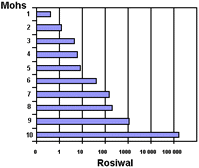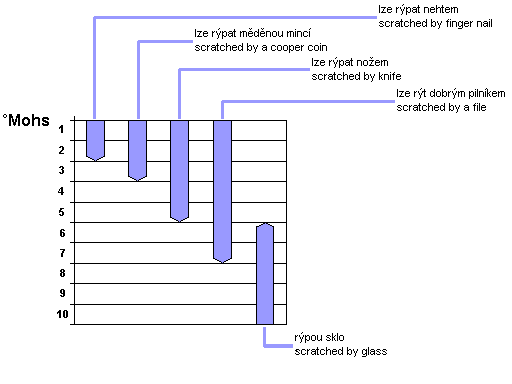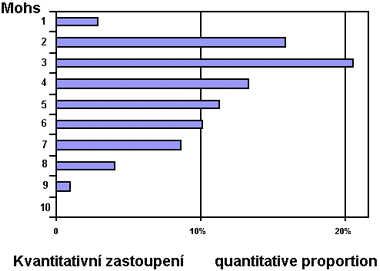

| Tvrdost nerostů není z fyzikálního hlediska zcela přesně definována. Je to celá řada vlastností založených na soudržnosti nerostů. Ve značné míře je tvrdost závislá na štěpnosti. Ve směru rovnoběžném se štěpnými trhlinami je nejmenší, kolmo na trhliny největší. U tvrdosti nerostů hraje velkou roli i vzdálenosti mezi strukturními částečkami (značné rozdíly jsou např. u některých polymorfních minerálů, jako je grafit-diamant) a poloměr atomů či iontů (minerály s atomy a ionty menšími jsou tvrdší, s většími jsou měkčí, jako příklad můžeme uvést silikáty a minerály obsahující hliník a kyslík na straně jedné, karbonáty a sulfáty na straně druhé). Přesto patří tvrdost, zejména při rychlém určování v terénních podmínkách, k nejdůležitějším diagnostickým znakům. | From the physical point of view, hardness is not a precisely defined characteristic. It includes a whole series of properties based upon the cohesion of minerals and depending to a great extent upon cleavage. If the cleavage plane is vertical to the plane under inspection, the hardness is lowest in the direction parallel to the cleavage rifts. Perpendicular to them it is highest. The cohesion between individual grains in polycrystalline minerals plays an important part in the hardness determination. Considerable hardness differences are found in polymorphic minerals, such as graphite and diamond, the size of their atoms and ions and the bonding between them plays an important part. Minerals with smaller atoms and ions tend to be harder; and those with larger atoms and ions tend to be softer. Hardness is one of the most helpful diagnostic features for obtaining quick identification of minerals in the field. |
| °Mohs | Typický nerost | typical mineral |
|---|---|---|
| 1 | mastek | talc |
| 2 | sůl kamenná | gypsum |
| 3 | vápenec | calcite |
| 4 | kazivec | fluorite |
| 5 | apatit | apatite |
| 6 | živec | orthoclase |
| 7 | křemen | quartz |
| 8 | topaz | topaz |
| 9 | korund | corundum |
| 10 | diamant | diamond |
| Pod pojmem tvrdost nerostu rozumíme odpor minerálu proti vniknutí jiného tělesa. V mineralogické praxi se vžily relativní srovnávací stupnice tvrdosti, reprezentované určitými minerály. Nejrozšířenější je tzv. Mohsova stupnice tvrdosti, která je desetičlenná a sestavená pouze z nerostů s bílým vrypem. Nerosty jsou zde seřazeny postupně tak, jak stoupá jejich tvrdost. Rozdíly v tvrdosti sousedních členů Mohsovy stupnice však nejsou stejné. U měkčích členů jsou malé, u nejtvrdších výrazně stoupají. | Hardness is the resistance offered by a mineral to mechanical abrasion. For its determina-tion, a hardness scale was established by Friedrich Mohs. It has ten grades represented by a set of standard minerals producing a white streak. They are arranged in order of increasing hardness. The difference in hardness between neighbouring minerals in the Mohs' scale varies from small differences among the lowest grades to larger differences among the last minerals. |

| Exaktnější metody, založené na obrusnosti (Rosiwal),vtlačování diamantového hrotu aj. našly své uplatnění pouze při testování kovů a v keramice. | More precise methods of determining the hardness based on the resistance of minerals to abrasion (Rosiwal), and to scratching with a diamond point, are applied mainly in testing metals and in the ceramics industry. |
Určování tvrdosti minerálů v terénu |
determination of hardness in situ |

| Srovnávací metodou
zkoušíme tvrdost tak, že rýpeme hrotem některého z
nerostů stupnice do plochy nerostu zkoumaného a obráceně. Hrotem proto,
že na hrotech se jeví tvrdost o něco větší než na plochách, takže dva
stejně tvrdé nerosty svými hroty rýpou do svých ploch. Nerost, který
rýpe a sám není rýpán, je tvrdší a je nutno přejít k nišímu členu
stupnice, až dojde k vzájemnému rýpání a otírání. Tlak při rýpání nemusí
být velký, ale stálý. Hrot nebo hrana kterou rýpeme, musí být ostrá.
Vzniklou rýhu otřeme a pro lepší kontrolu ji zkoumáme lupou. Při práci v teréu je však tento způsob nepraktický. K orientačnímu určování tvrdosti používáme k rýpání nehet - do tvrdosti 2 (minerály s tvrdostí kolem 1 jsou na omak mastné), měděnou minci - do tvrdosti 3, nůž - do tvrdosti 7. Minerály s tvrdostí 6 a výše rýpou do skla. Určování tvrdosti nerostů je do značené míry subjektivní záležitostí, a abychom se nedopustili podstatnějších chyb, je třeba dodržovat určitá pravidla. Ke zkoušení tvrdosti používáme jen nerosty právě nalezené a dostatečné velké. Plochy, na kterých chceme určovat tvrdost, by měly být rovné. Nerosty tvořící agregáty nebo nerosty navětralé mají tvrdost zpravidla menší než krystalovaný jedinec. Například hematit s tvrdostí 6 bude mít v době paprsčité nebo zemité tvrdost zřetelně nižší nežli samostatný krystal. Ke zkresleným hodnotám tvrdosti může dojít i u seskupení minerálů jehlicovitých, vláknitých, lupenitých apod. Zdánlivá změna tvrdosti je způsobena porušením soudržnosti, u křehkých nerostů pak lámáním ap. U některých kompaktních agregátů však můžeme zjistit zcela opačný jev, totiž vzrůst tvrdosti oproti izolovanému krystalu. Například velmi jemnozrnný agregát sádrovce budeme na rozdíl od krystalu jen velmi težko rýpat nehtem. Vzhledem k tomu, že tvrdost je vlastnost tenzorová, závislá na krystalických vazbách, vyskytují se u některých nerostů rozdíly v tvrdosti a závislosti na směru, v kterém plochu krystalu rýpáme. Zkouší proto tvrdost nerostů na různých plochách a v různých směrech. Jako výrazný příklad rozdílné tvrdosti v závislosti na směru může sloužit kyanit nebo kalcit. U krystalovaných jedinců, které chceme zařadit do zbírky,volíme místo pro zkoušku tvrdosti tak, abychom neporušili jejich estetický vzhled. |
The hardness of a
mineral may be tested by scratching it with the sharp
edge of another mineral from the scale, and vice versa. The edges of a
mineral are used because they are harder than its cleavage planes. The
hardness of the mineral in question and the scale sample is the same if
they scratch each other. If the mineral under determination can scratch
the mineral sample, but cannot itself be cut by it, it is harder and the
test may proceed to the next lower grade. Not much force on the
scratching point is needed - it only needs to be sharp. The scratch is
then wiped clean and investigated with a lens. In field work, however, this method is not always practical. Minerals of hardness 1 and 2 can be scratched by the finger nail, and have a soft greasy feel. A copper coin scratches minerals up to the hardness of 3, a pocket knife up to the hardness of 5, a steel file up to the hardness of 7. Minerals with a hardness 6 and over can scratch window glass. Hardness tests should be applied to fresh and sufficiently large mineral specimens. The surfaces lo be scratched should be flat. Mineral aggregates or weathered minerals have usually a lower hardness than the single or unaltered crystals of the same mineral. For instance, hematite (hardness 6) will have a lower hardness in the radiating or earthy form than in individual crystals. An incorrect determination of hardness can easily be made in needle-shaped, fibrous and foliated minerals, where the apparent change in hardness is caused by disturbed cohesion, or in brittle minerals by fracturing. On the other hand some compact aggregates show an increasing hardness when compared with their isolated crystals. For instance, a finely granular aggregate of gypsum compared with an isolated crystal can only be scratched by a finger nail with difficulty. Owing to the fact that hardness is a directional property and depends upon the mineral's internal crystal structure, some show a different hardness in different directions. Therefore, we must test the hardness of minerals both on different surfaces and in different directions. This property is seen most clearly in columnar kyanite or calcite. Crystals intended for collections should be tested very carefully lo avoid visible damage to their crystal faces. |


Home |
Příručka-Manual
E-mail: osvald.petr@mineralos.cz
![]()